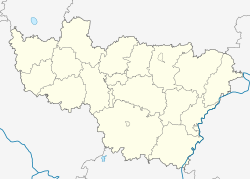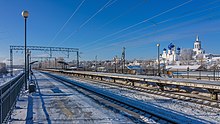Bogolyubovo
| Village
Bogoljubowo
Боголюбово
|
||||||||||||||||||||||||||
|
||||||||||||||||||||||||||
|
||||||||||||||||||||||||||
Bogoljubowo ( Russian Боголюбово , scientific transliteration Bogoljubovo ) is a village (selo) in the European part of Russia . The place has 4494 inhabitants (as of October 14, 2010) and, due to its historical importance, belongs to the tourist route of the so-called Golden Ring .
geography
Bogoljubowo is located in Vladimir Oblast , about 200 kilometers northeast of Moscow and 14 km northeast of the regional capital Vladimir . Administratively it belongs to the district ( Rajon ) Suzdal, the administrative seat of which Suzdal is about 30 km north. Immediately to the east of the village, the Nerl river flows into the Kljasma .
The Selo Bogoljubowo is one of the 16 localities that belong to the so-called rural settlement Bogoljubowo ( Сельское поселение Боголюбово ).
history
Bogoljubowo was founded in the middle of the 12th century and is one of the oldest localities in central Russia. In 1158 Andrei Bogoljubski , Grand Duke of Vladimir and Suzdal, had his new residence built there. He named the newly created place Bogoljubow-gorod and had the Church of the Mother of God (1158–1165) erected there as one of the first representative buildings , of which parts of the base are preserved today. The Church of the Protection and Intercession of the Virgin Mary, now a UNESCO World Heritage Site , was built near Bogoljubowo around 1165, during the reign of Andrei Bogoljubski.
In the 12th and 13th centuries the place was largely destroyed after several attacks by warring princes and during the invasion of the Golden Horde and temporarily left to decay. At the end of the 12th century, the former apartments of the Grand Duke were converted into a newly founded Russian Orthodox male monastery. As a suburb of the old grand ducal and metropolitan seat of Vladimir, Bogoljubowo, which was also located on the old postal route between Moscow and Nizhny Novgorod , still had city rights into the 16th century. The northern part of the place was formed by a so-called posad , an old Russian traders and craftsmen settlement .
After the rise of the Vladimir-Suzdal principality in the Grand Duchy of Moscow , Bogoljubowo lost its former importance and later also its city rights. During the Soviet era , the local spiritual life came to a standstill, and it was only in the 1990s that the churches and the monastery were again owned by the Russian Orthodox Church .
Population development
| year | Residents |
|---|---|
| 1959 | 2585 |
| 1970 | 3942 |
| 1979 | 4171 |
| 1989 | 4143 |
| 2002 | 4218 |
| 2010 | 4494 |
Note: census data
Attractions
The center of Bogoljubowo is relatively well preserved and still shows the remains of original fortifications from the 12th century (including earth walls, remains of fortification walls and the palace of the Grand Duke). The base of the former Church of the Mother of God , on which a baroque church was built in 1751 , as well as the well-known Church of the Protection and Intercession of the Virgin Mary on the Nerl , located on Nerl-Ufer 1 , also dates from the 12th century , 5 km east of Bogolyubovo is located. The Bogoljubski Monastery , which is now a women's monastery, houses historical sacred buildings from the 18th and 19th centuries, including the Cathedral of the Icon of the Mother of God from Bogoljubowo (1866) based on a design by the well-known architect Konstantin Thon .
Economy and Transport
Today Bogoljubowo is a popular tourist destination that has hardly any industry, mainly due to its monastery buildings and the old church on the Nerl. The most important traffic connections run through the nearby Vladimir. The M7 trunk road and the main railway line from Moscow via Vladimir to Nizhny Novgorod, where Bogoljubowo has a stop, run right past Bogoljubowo.
Sons and daughters of the place
- Jelisaveta Bykowa (1913–1989), chess player
Individual evidence
- ↑ a b Itogi Vserossijskoj perepisi naselenija 2010 goda. Tom 1. Čislennostʹ i razmeščenie naselenija (Results of the All-Russian Census 2010. Volume 1. Number and distribution of the population). Tables 5 , pp. 12-209; 11 , pp. 312–979 (download from the website of the Federal Service for State Statistics of the Russian Federation)




